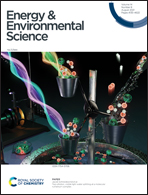Solid–electrolyte-interphase design in constrained ensemble for solid-state batteries†
Abstract
Solid-state-batteries (SSBs) represent one of the most promising directions in the energy-storage field. The development of SSBs, however, is currently limited by the complex [electro-]chemical reactions that inevitably occur at the interface of solid-state electrolyte (SSE) particles. Moreover, given the material complexity of such systems, there is no straightforward methodology for addressing these interface instabilities. In this work, a combined high-throughput ab initio computation and machine learning approach is used to study and design solid-state solid–electrolyte-interphase (SEI) with tunable electrochemical stabilities using our unique constrained ensemble description. Machine learning reveals that the ability of a solid-state SEI to be stabilized by the mechanical constriction effect is a nonconvex and nonlinear, but deterministic none-the-less, function of composition. The power of this approach is demonstrated using the interface of glass and ceramic sulfide families of solid-electrolytes. Finally, it is experimentally verified that the designed interfaces, in fact, decompose and electrochemically passivate based on our predictions.



 Please wait while we load your content...
Please wait while we load your content...